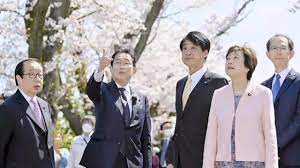TOKYO: Evacuation orders were lifted in small sections of a Japanese town just southwest of the wrecked Fukushima nuclear power plant on Saturday, in time for the area’s popular cherry blossom season, and Prime Minister Fumio Kishida joined a ceremony to mark the reopening.
The area of about 4 square km (1.5 square miles) where entry restrictions were lifted is part of Tomioka town, most of which was reopened after an earthquake and tsunami in March 2011 triggered triple meltdowns at the Fukushima Daiichi nuclear power plant.
Former residents and visitors celebrated the latest reopening as they strolled along a street known as “the cherry blossoms tunnel”.
Koichi Ono, 75, was back to the neighbourhood where he grew up and lived all his life until he was forced to evacuate. “After 12 years, I can finally return to my life here,” he told media. “The disaster hit when I was just starting my retirement life, so I’m starting all over again.”
The 2011 disaster caused massive amounts of radiation to leak from the plant, and more than 1,60,000 residents had to evacuate from across Fukushima, including about 30,000 who are still unable to return home.
Tomioka is one of 12 nearby towns fully or partially designated as no-go zones. The two sections in Tomioka that reopened for the first time in 12 years represent one-fifth of the worst-hit no-go zone.
“The living environment and many other things still need to be sorted out,” Tomioka Mayor Ikuo Yamamoto told the media. In the newly reopened Yonomori and Osuge districts of Tomioka, just over 50 of about 2,500 registered residents have reportedly returned or expressed intention to go back to live.
Only about 10 per cent of the town’s pre-disaster population of 16,000 have returned since large areas of Tomioka reopened in 2017.
Town surveys show a majority of former residents say they have decided not to return because they have already found jobs and educations and built relationships elsewhere.


